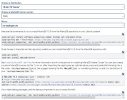stefan-franz
Basic Pleskian
Hello,
as a linux newbie, i would ask here for some help to update my database according on this tutorial.

 support.plesk.com
support.plesk.com
My system ist a virtual server at Strato. running is only 1 nextcloud on it.
Nextcloud shows me the following:
MariaDB version "10.1.48-MariaDB-0ubuntu0.18.04.1" is used.
Plesk 18.0.40 is running - all updates are made
I have an working Image from the strato backup system - so in worst case, i can recover my server.
Some questions:
What MariaDB version is recommend to use for the update? Has anyone here running a system where a updated mariadb workes?
Database basic questions
At the moment i save my database from time time under plesk, databases export. Is that enough to save my database (and is it possible to recover it if needed) or do i have that do as in the manual described with ssh under linux?
Create a backup of all databases with the following command:
MYSQL_PWD=`cat /etc/psa/.psa.shadow` mysqldump -u admin --verbose --all-databases --routines --triggers > /tmp/all-databases.sql
If i know the things above, i can go on.
as a linux newbie, i would ask here for some help to update my database according on this tutorial.

How to upgrade MySQL 5.5 to 5.6/5.7 or MariaDB 5.5 to 10.x on Linux?
Applicable to: Plesk for Linux Question How to upgrade MySQL 5.5 to 5.6/5.7 or MariaDB 5.5 to 10.X on Linux? Answer This article provides instructions for upgrading MySQL 5.5 to 5.6/5.7 and Mari...
My system ist a virtual server at Strato. running is only 1 nextcloud on it.
Nextcloud shows me the following:
MariaDB version "10.1.48-MariaDB-0ubuntu0.18.04.1" is used.
Plesk 18.0.40 is running - all updates are made
I have an working Image from the strato backup system - so in worst case, i can recover my server.
Some questions:
What MariaDB version is recommend to use for the update? Has anyone here running a system where a updated mariadb workes?
Database basic questions
At the moment i save my database from time time under plesk, databases export. Is that enough to save my database (and is it possible to recover it if needed) or do i have that do as in the manual described with ssh under linux?
Create a backup of all databases with the following command:
MYSQL_PWD=`cat /etc/psa/.psa.shadow` mysqldump -u admin --verbose --all-databases --routines --triggers > /tmp/all-databases.sql
If i know the things above, i can go on.



